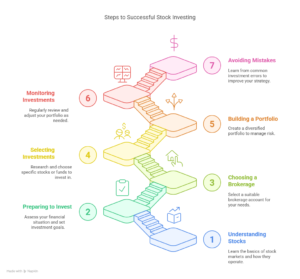earn how to invest in stocks with this beginner-friendly guide. Discover essential steps, tips, and strategies to start your investment journey confidently.
Stock investing is one of the best ways to build wealth over the long term. You become a partial owner of companies by buying shares, and can profit from their rise and profitability. This guide will provide you with the basics, and it will even offer you a list of books, articles, and other resources to help you continue to learn how to start investing in stocks once you have completed this guide (even if you are new to the world of finance).
Table of Contents
Understanding Stocks
What Are Stocks?
Stock is a share of a company. When you purchase a stock, you own a piece of that company. The value of your stock may rise as the company grows and becomes more profitable. In addition, some companies pay out dividends, which is the share of the profits paid out to shareholders.
Types of Stocks
- Common Stocks: Most investors own common stocks, which often result in voting rights and dividends.
- Preferred Stocks: These stocks do not usually carry voting rights; however they have a higher claim in terms of assets and profits (fixed dividends).
Preparing to Invest
Before diving into the stock market, it’s crucial to ensure you’re financially prepared.
Assess Your Financial Situation
-
Emergency Fund: Ensure you have savings to cover 3–6 months of living expenses.
-
Debt Management: Pay off high-interest debts to avoid financial strain.
-
Budgeting: Create a budget to determine how much money you can afford to invest without affecting your daily needs.The Balance+1The Balance+1
Determine Your Investment Goals
Are you investing for retirement, a major purchase, or to grow your wealth? Your goals will influence your investment strategy and risk tolerance.
Choosing a Brokerage Account
You will need to open a brokerage account in order to buy and sell stocks.
Types of Brokerage Accounts
- Full-Service Brokers: Provide the most personalized advice and services, but they charge higher fees.
- Discount Brokers: Offer the possibility to order stocks with much lower fees but with less personalized service.
Factors to Consider
- Fees and Commissions: The costs for each broker will vary.
- Account Minimums: Some brokers also require minimum deposits to open an account.
- Tools and Resources: Make sure the broker provides you with investing tools and educational resources to support your investment decisions.
Selecting Your Investments
After you have your brokerage account, it’s time to decide where to invest.
Individual Stocks vs. Funds
- Single Stocks: This type of investment gives you potential for more return, but it also comes with more risk.
- Mutual Funds and ETFs: These funds combine money from individuals to buy a diversified portfolio of stocks, which limits the exposure of individuals to any one stock.
Researching Investments
- Company Performance – Examine the financial statements, earnings reports and market position.
- Industry Trends: What’s Driving the Market Growth? What are the Challenges to Market Growth?
- Economic Indicators: Think about things such as interest rates and inflation that might affect how stocks perform.
Creating an Asset-Diverse Portfolio
Diversification is a way to reduce the risk of investment by spreading it through different sectors of the economy and types of assets.
Why Diversify?
- Diversification: mitigates the impact of an underperforming investment on your entire portfolio.
How to Diversify
- Diversify: Invest in technology, healthcare, and finance.
- Divide assets: among asset types)Stocks, bonds, real estate.
- Global Rebound: Look at the world for your investments.
Monitoring and Adjusting Your Investments
You should be reviewing your investments to make sure they are working for you.
Reviewing Performance
- Quarterly Reports: Check the earnings and growth.
- Market: Know the market conditions that can influence your investments.
Making Adjustments
- Rebalancing: Fine-tune your portfolio to stay in line with your desired mix of asset classes.
- Reinvest the Dividends: Look into complementing your dividends and compounding your money.
Common Mistakes to Avoid
If only you knew what to look for then you would avoid the common pitfalls.
Emotional Investing
Emotional decision-making, as opposed to rational, can create bad investment decisions.
Overtrading
Active trading can lead to higher fees and tax implications.
Ignoring Fees
Ignoring brokerage fees and fund expenses can grind down your investment returns over time.
Frequently Asked Questions
Q1: How much money should I have to start investing in stocks?
A lot of brokers will let you start with as little as $50 to $100.
Q2: Is investing in stocks risky?
All investments are risky, but diversification and research can help you manage that risk.
Q3: How can I keep track of my investments?
Most brokerage platforms provide you tools to help you keep an eye on how your portfolio is doing.
Q4: Individual stocks or mutual funds?
The answer depends on how risk-tolerant you are and what you want to accomplish with your investment. Mutual funds provide diversification and individual stocks produce higher returns.
Q5: Can I invest through retirement accounts in stocks?
Yes, accounts



